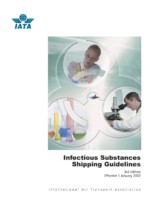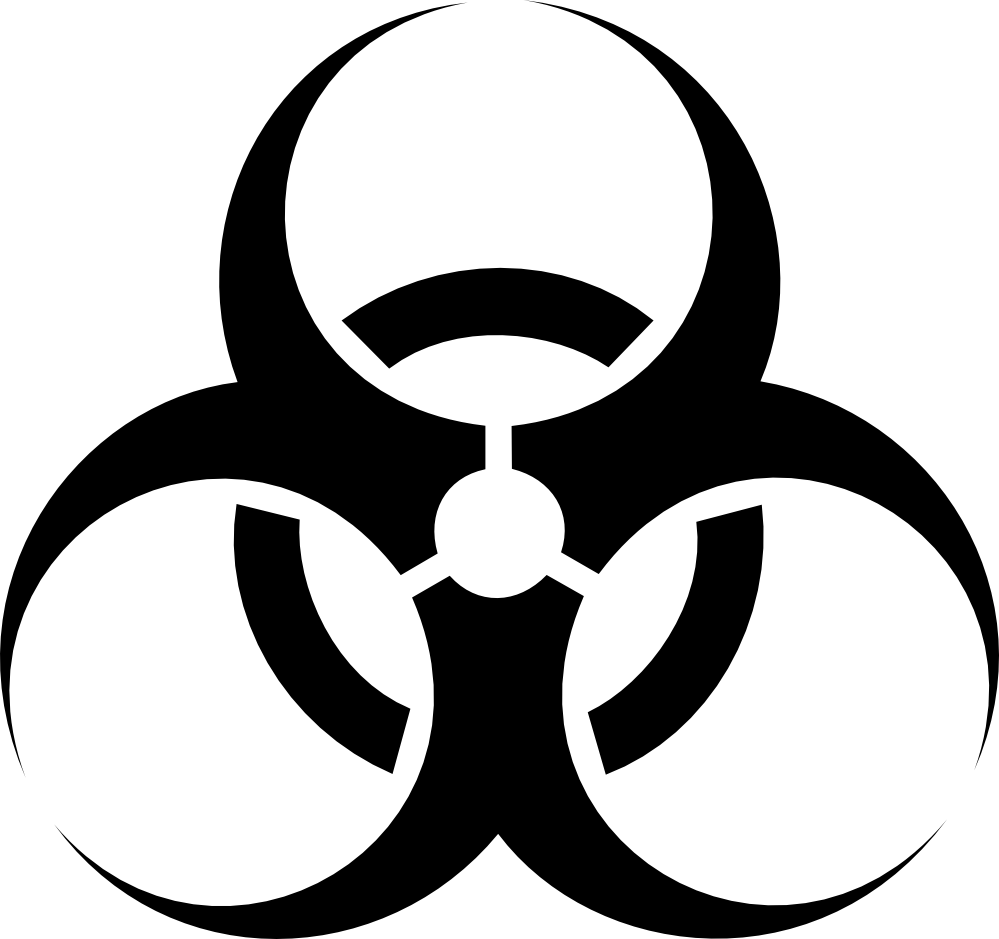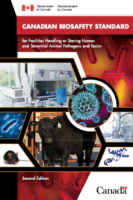Rumor Management
Pertinent Government Agency Alerts
ABSA/OSHA Fact Sheets
Select Agent Disease Fact Sheet(PDF 430KB)
Zoonotic Fact Sheet(PDF 533KB)
Principles of Good Microbiological Practice Fact Sheet(PDF 224KB)
Principles of Biosafety Fact Sheet (PDF 117KB)
BioSafety Levels (US)(PDF 132KB)
Lentivirus Vector Fact Sheet(PDF 203KB)
For best results print fact sheets on legal-sized paper with a color printer.
Department of Health and Human Services
Center for Disease Control and Prevention
NIH Office of Biotechnology Activities (OBA)
Food and Drug Administration (FDA)
National
Institute for Occupational Safety and Health (NIOSH)
Department of Agriculture (USDA)
Animal Plant Health Inspection Service (APHIS)
U.S. Department of Transportation (DOT)
US Environmental Protection
Agency (EPA)
APHL Biosafety & Biosecurity page
http://www.aphl.org/biosafety
OSHA Home Page
http://www.osha.gov/
Environmental Protection Agency Home Page
http://www.epa.gov/
Nuclear Regulatory Commission Home Page
https://www.nrc.gov/
Food and Drug Administration Home Page
http://www.fda.gov/
Research and Special Projects Administration (RSPA)
www.bts.gov
Federal Register Search Engine
https://www.federalregister.gov/
Code of Federal Regulations Search Engine
Code of Federal Regulation (Annual Edition)
These are agencies with references to EHS in general and biological safety in particular.
WHO Home Page
http://www.who.int/
Belgian Biosafety Server (This site has tons of references for all of Europe!)
http://www.biosafety.be/
Health and Safety Executive UK
http://www.hse.gov.uk/
ORDA Home Page
http://osp.od.nih.gov/office-biotechnology-activities/oba/index.html
NIH rDNA Guidelines (new format)
http://oba.od.nih.gov/rdna/nih_guidelines_oba.html
CDC Home Page
http://www.cdc.gov/
International Air Transport Association
http://www.iata.org/whatwedo/cargo/dangerous_goods/Pages/index.aspx
National Sanitation Foundation Internal Home Page
http://www.nsf.org/
State Workers’ Compensation Officials
http://www.dol.gov/owcp/dfec/regs/compliance/wc.htm
50 State’s Regulatory Agencies Websites
Health and Environmental Agencies of U.S. States and Territories
State and Local Government on the Net
http://www.statelocalgov.net
Good Microbiological Practices and Procedures (GMPP), videos 1-7
Biological safety cabinet (BSC), videos 1-4
WHO’s Good Microbiological Practices and Procedures (GMPP) video series
Guidelines for Safe Work Practices in Human and Animal Medical Diagnostic Laboratories, Recommendations of a CDC-convened, Biosafety Blue Ribbon Panel, CDC, Morbidity and Mortality Weekly Report (MMWR), January 6, 2012
Guidelines for Biosafety Laboratory Competency(PDF 420KB), CDC/APHL, Morbidity and Mortality Weekly Report, April 15, 2011
CDC/NIH: Biosafety in Microbiological and Biomedical Laboratories
6th Edition
International Federation of Biosafety Associations (IFBA)
Arthropod Containment Guidelines, Version 3.2, American Committee of Medical Entomology; American Society of Tropical Medicine and Hygiene, Vector Borne and Zoonotic Diseases, February 27, 2019
Editorial
Guidelines
S3: Science, Safety, and Security
Biosecurity, Biosafety, Biocontainment, and Biorisk management
CDC/NIH: Primary Containment for Biohazards: Selection, Installation and Use of Biological Safety Cabinets(PDF )
3rd edition, September 2007
CETA Application Guide for the Exhaust System Requirements of Class II, Type B Biosafety Cabinets (available on the NuAire website)(PDF 315KB)
CAG-007-2010, March 24, 2010
Guidelines for the Safe Transport of Infectious Substances and Diagnostic Specimens (PDF 286k)
WHO-1997
Canadian Biosafety Standard (CBS) Second Edition
Second Edition, March 11, 2015
NIH Design Criteria for laboratory construction
World Health Organization Laboratory Biosafety Manual
3rd Edition, 2004.
Animal Plant Health Inspection Service (APHIS)
Bloodborne Pathogens 29 CFR 1910.1030 (OSHA)
Bloodborne Pathogens Compliance Directive (PDF)
CDC Correspondence to ABSA regarding Final Rule(MSWord 48k)
United States Government Policy for Institutional Oversight of Life Sciences Dual Use Research of Concern
Released September 24, 2014
DURC Policy(PDF 616KB)
DURC Companion Guide(PDF 901KB)
Food and Drug Administration (FDA)
Hazardous Materials Regulations (49 CFR 100-185)
Hazardous Waste (EPA)
HHS security guidelines for synthetic DNA manufacturers
IAQ (EPA)
Needlestick Standard (OSHA)
NIH Guidelines for Research Involving Recombinant DNA Molecules
Occupational Exposure to Hazardous Chemicals in Laboratories
29 CFR 1910.1450 (OSHA)
Pathogen Safety Data Sheets and Risk Assessment(Public Health Agency of Canada)
Pocket Guide to Chemical Hazards
Personal Protective Equipment
(29 CFR 1910.132-139)
Respirator (NIOSH)
Select Agent Final Rule
Department of Health and Human Services (DHHS) (PDF 247KB)
Select Agent Final Rule
US Department of Agriculture (USDA) (PDF 333KB)
Import Permit Program (IPP)
US Department of Commerce provides information on the export of infectious substances and other biological materials:[link broken make a suggestion]
Both the BMBL and Etiologic Agent permits pages and other biosafety reference information can be reached through the CDC Office of Health and Safety biosafety page:
USDA Veterinary Services National Center for Import and Export[link broken make a suggestion]
APHIS website for import and shipment permits for animal and plant pathogens as well as biotechnology (plant and agricultural microorganism) permits:
https://www.aphis.usda.gov/aphis/ourfocus/importexport
Draft FDA guidance document on selection of disposable gloves
Surveillance and Detention Without Physical Examination of Surgeons’ and/or Patient Examination Gloves
NIH Division of Safety Publications website
https://www.ors.od.nih.gov/sr/dohs/safety/Pages/publications.aspx
Dictionary of Safety Terms – Spanish to English
http://www.orosha.org/pdf/dictionary/spanish-english.pdf
Dictionary of Safety Terms – English to Spanish
http://www.orosha.org/pdf/dictionary/english-spanish.pdf
Download the ABSL1-4 Matrix(XLS 312KB)
Download the BSL2-4 Matrix(XLS 300KB)
UPDATED–Letter to the Editors as published in (Vol. 13, No. 3, 2008)

Infectious Substances Shipping Guidelines
Everything you need to know about shipping infectious substances safely. Learn how to ship infectious substances by any mode of transport anywhere in the world. The Infectious Substances Shipping Guidelines are outlined in a convenient, easy-to-read manual with up-to-date information on the regulations. This time saving handbook features easy-to-follow transportation guidelines for road, air and courier, sets out national and international regulations and provides training requirements and examples of actual documentation. The how-to checklists cover every step of the shipping process including classification, identification, packaging, marking, labelling and handling. Published annually only in English.
Available on the IATA online store
FAQs for New Select Agent Regulation (42 CFR 73)
Interim Final Rule: CDC; Possession, Use, and Transfer of Select Agents and Toxins; 42 CFR Part 73
Interim Rule: Animal and Plant Health Inspection Service; Agricultural Bioterrorism Protection Act of 2002; Possession, Use, and Transfer of Biological Agents and Toxins [link broken make a suggestion]
USA PATRIOT Act: Expansion of the Biological Weapons Statute (PDF 78k)
NIH: Dual-Use Research
NIH: Biosafety and Biosecurity Policy
Sandia National Laboratories: Laboratory Biosafety and Biosecurity Risk Assessment Technical Guidance Document(PDF) – Includes biosecurity risk assessment considerations
US HHS: S3: Science, Safety, Security website: Biosecurity: Law & Policy – The Law & Policy section will give you a clear understanding of the many laws, regulations, policies, and guidance documents that exist around Biorisk Management.
Applied Biosafety: Journal of ABSA International 2019, Vol. 24(1) 34-45: The Culture of Biosafety, Biosecurity, and Responsible Conduct in the Life Sciences: A Comprehensive Literature Review(PDF), Perkins D, et.al
Government of Canada: Biosecurity Central – Biosecurity Central is a publicly available web-based library that helps users find relevant and reliable sources of information for key areas of biosecurity. It includes guidelines, policies, legislaation, protocols, & training materials for worldwide agencies.
European Biosecurity Regulators Forum: European Biosecurity Regulation Forum Guidelines for the implementation of Action B2 (March 2014)
WHO: Laboratory biosecurity guidance, 2024
International Working Group: Culture of Biosafety, Biosecurity, and Responsible Conduct in the Life Sciences: (Self) Assessment Framework
AAAS Center for Science, Technology and Security Policy
http://cstsp.aaas.org
Bioterorism Resources, Association for Professionals in Infection Control and Epidemiology, Inc.
Infectious Disease Disasters: Bioterrorism, Emerging Infections, and Pandemics(PDF)
CDC’s Bioterrrorism website
Emergency Preparedness and Response, Bioterrorism webpage
U.S.Army Medical Research Institute of Infectious Diseases (USARMRIID), Fort Detrick, MD
Health Canada/ Office of Biosafety : Bioterrorism Statement
http://www.hc-sc.gc.ca/pphb-dgspsp/publicat/ccdr-rmtc/01vol27/dr2704ea.html
Bioterrorism Readiness Plan – A Template for Health Care Facilities, APIC
http://www.apic.org/Content/NavigationMenu/PracticeGuidance/Topics/Bioterrorism/Bioterrorism.htm#Readiness_Planning
Bioterrorism and Public Health Summary (Health Canada)
http://www.hc-sc.gc.ca/pphb-dgspsp/publicat/ccdr-rmtc/01vol27/dr2704ea.html
Biological and Chemical Terrorism: Strategic Plan for Preparedness and Response. Recommendations of the CDC Strategic Planning Workgroup. MMWR 49 (RR04):1-14. April 21,2000
http://www.cdc.gov/mmwr/preview/mmwrhtml/rr4904a1.htm
Center for Biodefense Studies (John Hopkins University)
https://centerforhealthsecurity.org/
Hawley, Robert J., PhD. “Biological Weapons – A Primer for Microbiologists”, Annual Review of Microbiology and Human Genetics, 55:235-253. 2001.
The Homeland Defense and Security Information Analysis Center
https://www.hdiac.org/
FM3-3 Chemical and Biological Contamination Avoidance, Chapter 4, Biological Agents, U. S. Army
Enlistment.US: Field Manual 3-3 – Chemical and Biological Contamination Avoidance
Chemical and Biological Weapons Non-proliferation Project
http://cns.miis.edu/programs/cbwnp/
Federation of American Scientists, Non Proliferation of Weapons of Mass Destruction
http://www.fas.org/
Title 32 CFR 627, Subpart H.200, DA Pamphlet 385-69. The Biological Defense Program. Technical Safety Requirements
http://www.access.gpo.gov/nara/cfr/waisidx_00/32cfr627_00.html
Medscape – Bioterrorism: Preparing for the Future (Accessible from CDC Bioterrorism website, you must register to access information through Medscape)
http://www.medscape.com/
National Symposium on Medical and Public Health Response to Bioterrrorism, Emerging Infectious Diseases, Volume 5, No. 4, July – August 1999
http://www.cdc.gov/ncidod/eid/vol5no4/pdf/v5n4.pdf
NATO Handbook on the Medical Aspects of Defensive Operations AmedP-6(B), Part II -Biological
http://www.fas.org/nuke/guide/usa/doctrine/dod/fm8-9/2toc.htm
Investigating Disease Outbreaks under a Protocol to the Biological and Toxin Weapons Convention
Mark Wheelis, University of California, Davis, California USA . Emerging Infectious Diseases 6 (6) 2000 CDC
http://www.ncbi.nlm.nih.gov/pmc/articles/PMC2640916/
GAO: High-Containment Laboratories: Improved Oversight of Dangerous Pathogens Needed to Mitigate Risk
http://www.gao.gov/products/GAO-16-642
NIH ClinicalTrials.gov
https://clinicaltrials.gov
American Conference of Governmental Industrial Hygienists (ACGIH)
http://www.acgih.org
American Industrial Hygiene Association (AIHA)
http://www.aiha.org
BIOLOGICAL AGENT REFERENCE SHEET, Zika Virus (ZIKV)
http://www.ehso.emory.edu/content-guidelines/BARS-Zika-Virus.pdf
From the CDC website:
Healthcare-associated Infections
January 17, 1997 CDC Needle Safety Device Study
RTECS – Registry of Toxic Effects of Chemical Substances
The BMBL is available directly from:
https://www.cdc.gov/labs/bmbl/index.html
CDC Prevention Guidelines Database
Consolidated CDC Post- Exposure Recommendations (June 29,2001)
DHHS/PHS National Toxicology Program, 14th Report on Carcinogens
From the OSHA website:
Latex Allergy folder
http://www.osha.gov/SLTC/latexallergy/index.html
OSHA: Bloodborne Pathogens and Needlestick Prevention
Emergency Care Research Institute
https://www.ecri.org/
Training for Development of Innovative Control Technologies
http://www.tdict.org/
California SHARPS Program
http://www.dir.ca.gov/dosh/cal_vpp/eagle.html
Occupational & Environmental Medicine
http://www.acoem.org/welcome.htm
National Pesticide Information Center
http://npic.orst.edu/
Canadian Pathogen Safety Data Sheets (PSDS)
http://www.phac-aspc.gc.ca/lab-bio/res/psds-ftss/index-eng.php
American Type Culture Collection
http://www.atcc.org/
Virus Databases on Line
https://talk.ictvonline.org/taxonomy/
Journal of Gene Medicine
https://onlinelibrary.wiley.com/journal/15212254
Knowing How to Practice Safe Science (Howard Hughes Institute)
http://www.practicingsafescience.org/
OIE – World Organization for Animal Health
https://www.oie.int/
Update: Investigation of Anthrax Associated with Intentional Exposure and Interim Public Health Guidelines, October, 2001
http://www.cdc.gov/mmwr/preview/mmwrhtml/mm5041a1.htm
Recognition of Illness Associated with the Intentional Release of a Biologic Agent
http://www.cdc.gov/mmwr/preview/mmwrhtml/mm5041a2.htm
Investigation of case of anthrax in Texas Laboratory Worker
http://www.cdc.gov/mmwr/preview/mmwrhtml/mm5113a4.htm
Investigation of case of anthrax in Texas Laboratory Worker
http://www.cdc.gov/mmwr/preview/mmwrhtml/mm5122a4.htm
ASHRAE Report: “Risk Management Guidance for Health and Safety Under Extraordinary Circumstances” – January 12, 2002 (PDF. file, under “News and Events”)
http://www.ashrae.org/
Lawrence Berkley National Laboratory
CDC/NIOSH Protecting building enveionments from airbonre CBR attacks. Potential replacement
https://www.cdc.gov/niosh/docs/2002-139/pdfs/2002-139.pdf
Office of Homeland Security
Department of Homeland Security







